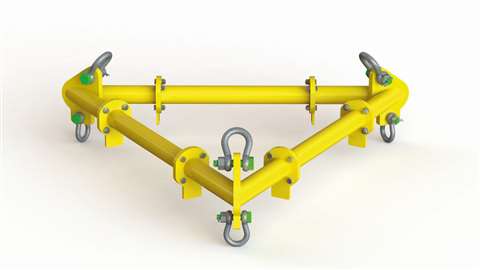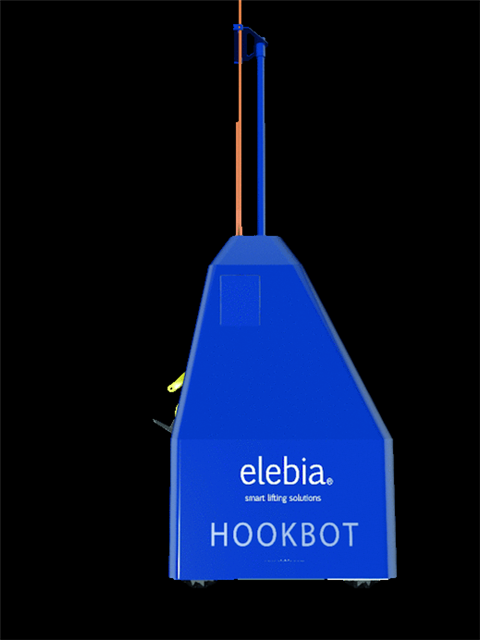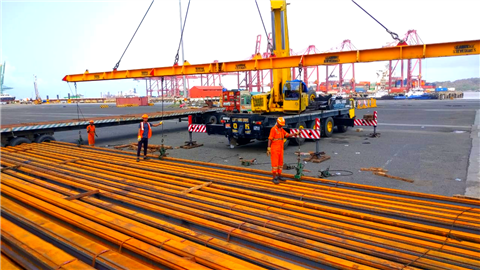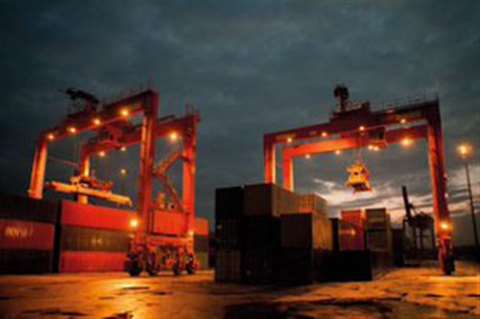Why below the hook equipment maximises safety and efficiency
22 November 2021
Below the hook lifting devices help ensure safe and reliable load transport, reducing the risk to equipment and workers, especially when moving unusual sizes and shapes or heavy loads. Niamh Marriott reports.
Returning to live events has meant customers and end-users can see the new products in real life and get a sense of what is the latest and greatest out there. UK-based spreader beam and specialist engineering company Modulift launched TriMod, a new product designed for 3-point and circular lifts at the Vertikal Days show in September.
 Modulift launched TriMod, a new product designed for 3-point and circular lifts at the Vertikal Days show in September
Modulift launched TriMod, a new product designed for 3-point and circular lifts at the Vertikal Days show in September
Created by the in-house engineering team and manufactured in the factory in Poole, Dorset, the product is a triangular frame that can be extended for 6-point lifts and multipoint circular lifts due to its shape, and all the TriMod corner units are compatible with Modulift spreader beams.
Harshal Kulkarni, engineering manager at Modulift says, “Our team have wanted to develop a product which would change the lifting industry and in particular, design and manufacture a product which is suitable for complicated circular lifts as we have seen an increase in enquiries over recent months.”
The company said that its design makes rigging configuration easy to assemble and that due to the shape, it can be used for circular lifts, particularly when lifting tank roofs and pressure vessels.
New Modulift products
Another recent offering from Modulift is its Clevis Drop Link and Delta Plate, designed to replace the standard Drop Link for certain specific rigging situations and make rigging quicker, safer and more efficient.
The company says the construction of the new design is unique and the different size Delta plates offered are suitable for various bottom shackles, which can be installed in the same Clevis Drop Link, making the product flexible and compatible with a range of shackles.
Tested and certified in accordance with DNV-ST-0378, the product is supplied ready assembled so relatively easy to put together on site, with two smaller size shackles replacing one large lower shackle as seen in a standard spreader configuration. The flexibility enables variable angles on the bottom slings ranging from 0 to 45 degrees.
“We are continually looking for new ideas to make rigging more efficient whilst maintaining safety. Feedback from site trials have confirmed that the product is really easy to use and saves time rigging up especially when doing repetitive lifts,” said John Baker, Modulift commercial director.
Eager.one and Boskalis
Customisation and project-specific design can make a lift safer but also save time and money. Dutch specialist Eager.one was tasked by Boskalis to design and fabricate a specialized Jacket Lifting Tool (JLT) for an installation project of an offshore wind farm near Taiwan, to be used during loading, unloading and installation of 62 jackets.
 Eager.one’s lifting beam for the vessel Gulliver
Eager.one’s lifting beam for the vessel Gulliver
During the installation work, the tool will be used for load-out from the quayside on board the heavy lift vessel and will be deployed for lifting the jackets from the heavy lift vessel to the final installation position. The tool, designed with six clamps to jointly lift the jacket, measures approximately 8 by 6 by 5 metres and has a total working load limit of 2,233 tonnes. To minimise tilt, the tool has a centre of gravity (CoG) adjustment system.
The complete hydraulic system, cameras and lighting are all powered by battery packs, which eliminates the need for an umbilical. The jacket lifting tool has an hydraulic umbilical to be able to release the JLT in case of emergency. A guide frame and sea fastening were included in this challenging design and construct project.
Eager.one was also commissioned by Scaldis to design and construct a lifting beam for its vessel Gulliver. The new system is designed to minimise the exposure when connecting the rigging, which is controlled by auxiliary lifting hoists, hydraulic pin-pushers and lower link plates. A key feature of the design is that the beam has two skiddable forks, the green and red parts of the beam. These forks can be positioned and aligned remotely by a hydraulic push-pull system, placed above the lifting points, which shortens the rigging.
Elebia’s hookbot
Lowering risk on offshore projects is a clear priority and Elebia’s hookbot has been designed to improve safety when handling containers from service vessels on maritime platforms, especially in extreme conditions. The Hookbot is an autonomous remote-controlled robot that allows the remote movement on a flat surface with obstacles. It is a compact and robust robot which carries an evo20 automatic hook and hangs from the crane’s hook.
 Elebia’s hookbot is designed to cope with extreme conditions
Elebia’s hookbot is designed to cope with extreme conditions
There has also been major development in the area of chain and sling technology. Green Pin’s Tycan lashing and lifting fibre chain is made from Dyneema, an ultra-high molecular weight polyethylene material. It’s up to eight times stronger than steel chain but just as tough, the company said. This means it can reduce the risk of bad backs for workers, as well as cuts, bruises and hearing damage associated with steel.
Green Pin Tycan has been tested in production facilities and in real-life circumstances, the company says. It has been qualified for both lashing and lifting operations by DNV-GL and has been used already by companies like Mammoet. The chain is resistant to chemicals, grease, dirt, salt and low temperatures.
Designed for use with synthetic slings, CM Quick-Connect Hooks are an easy way to add hooks to synthetic slings, without the need for additional hardware, as they can just be slipped on and won’t come out unless purposely removed. Available with a wide bearing surface and appropriate radius, the hooks prevent the sling from bunching, and can prevent the slings from contacting abrasive surfaces or sharp edges of the load. This means the slings last longer and there is no need for additional edge protection. The hooks are available with working load limits up to 5,987 kilogrammes.
ON THE RIGHT TRACKS
Total Movements, member of the Worldwide Project Consortium (WWPC) in India, used special below the hook lifting equipment to deliver 50,000 metres of steel rail for railway lines to the Pune Metro Project in Pune, India. It was charged with receiving the cargo under the ship’s hook until its delivery to the project site, including unloading and stacking. Despite facing challenges like a cyclone, heavy rains, resource scarcity, and tough coronavirus restrictions, the cargo was safely moved on time. |
AUTOMATING EFFICIENCY
Automation can be a huge benefit and retrofitting new technology can save time. Strainstall CWS automatic instrument weighing solution has been approved in New Zealand for reach stackers, straddle carriers, RTG (rubber tyred gantry) cranes and RMG (rail mounted gantry) cranes. The system enables container weighing to be accurately completed during stacking operations at ports and terminals, removing the need for weighbridges. The company says it can streamline the process and offer efficiency increases of up to 300 per cent. The system is already installed at a number of international terminals, including DP World Southampton, UK, and Yilport Ferrol in Spain. |





